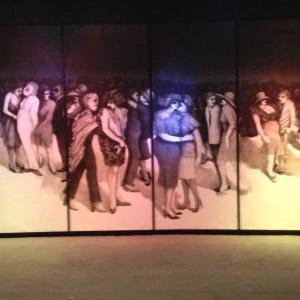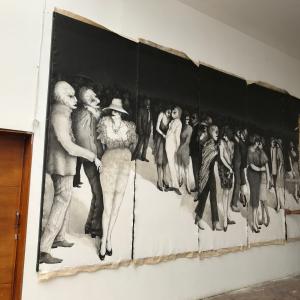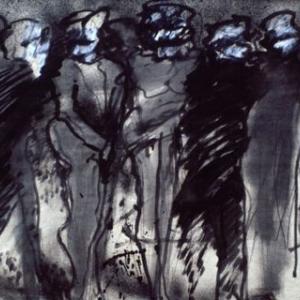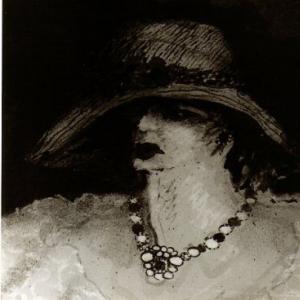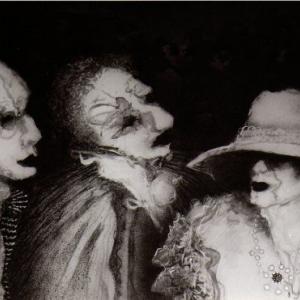critics
ARTSPEAK
New York
Octubre 86
One sees in the paintings of Alicia Viteri, at INTAR Hispanic Arts Center, an outlook of life and people that has unfortunately gone sour. In her six panel mural installation in black and white, her subjects walk on the street, living ghouls with repulsive erotic intentions. Here is something of the George Grosz attitude, if not exactly the style. This young panamanian is an effective caricaturist, a draftsman capable of employing line and rhythm to create movement. Also, she is one who knows how to manipulate light.
Viteri’s black and white small sketches for her “Funeral Series” approach a sense of Goya. In one of her good size oils in color of her Carnival Series, a fleshy dancer in the foreground contrast with the “blue people” beyond. Each series broaden the range of the artist. Alicia Viteri projects a powerful message of man’s fate, showing the cause in man’s own unremittingly cruel nature.
,MARITZA URIBE DE URDINOLA
Museo de Arte Moderno La Tertulia. Cali
1986
Suddenly, a crowd turned to the beat of a sound that mixes tropical rhythms, the voices of the vendors, the shrillness of the cars, in short, all the deafening noise of the city centers filled the great hall of the Museo de Arte Moderno La Tertulia, in Cali. The attendees received a ghostly impression created by the light effects, merging with the huge backdrop in which Alicia had described an amazing carnival.
Were indeed alienated everyone that in a moment turned their presence into an act of participation, the the truth is that “the carnival” did not end where the painting ended. There was another with living figures, not stationary, they merge, disappear pick up again and become a magnetic vortex. At one point we felt we were living a dream or a nightmare. Anyways it was a surrealistic sight, perhaps because that painting apparently real and that proposed a party, was far beyond the present it was a funeral and everyone was confused with those figures that magically attracted them. They merged and became part of the work. Hence the enormous strength of his painting, especially in those backdrops, where you do not use harsh colors but only the whites and blacks with a highly successful effect of the lights, appear as if it were a big multicolor wall.
Since it's beginning with kafkian engravings from an early time he sensed the teacher that she was going to become later. A teacher specially, when it comes to the use of chiaroscuro and grays.
However, there is a common denominator among its giant curtains and very polished works of smaller format. It is somewhat ironic, subtle, both in insects and in the faces of those women who seem to keep out from the analysis. The world of someone possessing a rich interior which gives us a small sample the pencil or chisel and loose it moorings when its' decided to tell us that life is a carnival that precedes death and “the rest is worth nothing less”.
,MARTA RODRIGUEZ
BOGOTA 1997
Centro Colombo Americano
Bogotá
The exhibition that is currently presenting Alicia Viteri in Bogotá, as it is conceived, stands on one hand on the value of the process and on the other, raises the possibility of promoting a more participatory reception by the viewer. The mural becomes the landscape of the public so that anyone who observes it becomes a character in this dance of life is, the product of an exploration that has made Alicia Viteri about the human condition, research that is in debt with the fantastic and terrifying literature of Poe and Lovecraft. This participation achieved through the use of sound, the handling of light and the scale of the work, elements that contribute on creating an atmosphere that exceeds the two-dimensional condition of drawing and painting, atmosphere that engages the viewer with the funeral and the Carnival which is represented in a great fabric of 7 mts. x 3 mts., where pain and joy are the main topics .
The stage is expanding and wants to go beyond the limits of its two-dimensionality, wants to cover the field of a bodily experience, sensory and perceptive that works on the viewer's everyday life. Alicia Viteri wants that his characters to come to life through the movements of the viewer, each of them as characters in the crowd, and start speaking from our presence, stating that the art breaks the fields of art and breaks through all the areas of life. The mural will be the landscape, then his voice fades with the crowd and merges with the voices that accompany the funeral and the songs of the carnival while the fabric collides and eventually are intertwined. But when you look at the video image captured by an imperceptible camera while all this was happening, you will realize that Alicia Viteri has achieved it's purpose, because you may not know where the fabric ends and where life begins.
